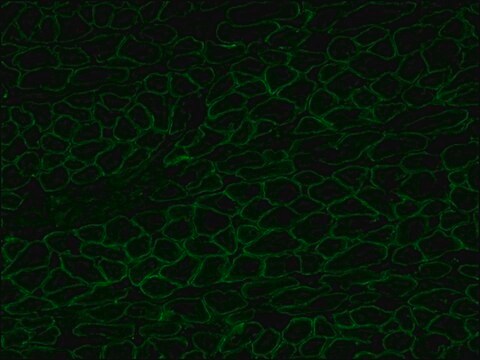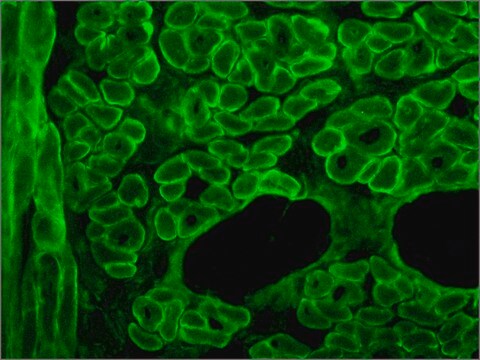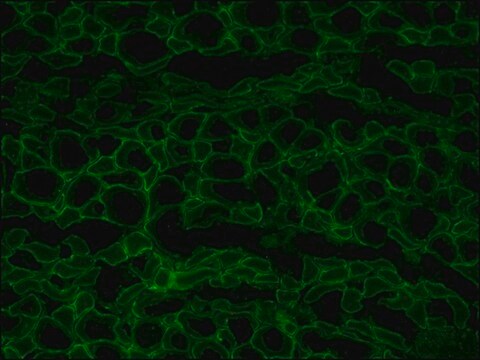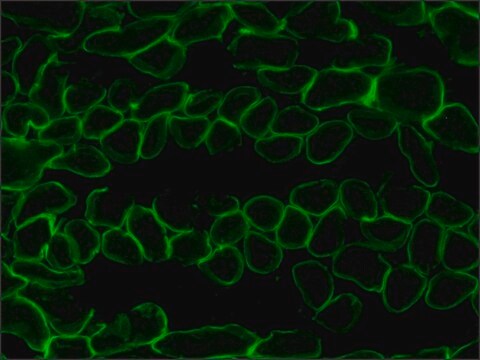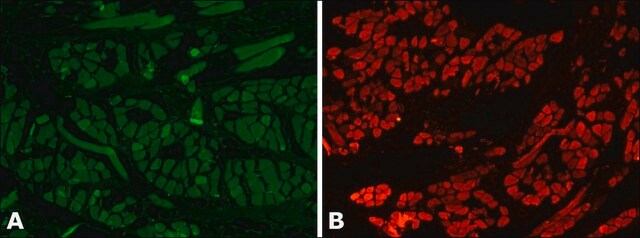MABT827
Anti-Dystrophin Antibody
mouse monoclonal, 2C6 (MANDYS106)
Synonim(y):
Dystrophin
About This Item
Polecane produkty
Nazwa produktu
Anti-Dystrophin Antibody, clone 2C6 (MANDYS106), clone 2C6 (MANDYS106), from mouse
pochodzenie biologiczne
mouse
Poziom jakości
forma przeciwciała
purified antibody
rodzaj przeciwciała
primary antibodies
klon
2C6 (MANDYS106), monoclonal
reaktywność gatunkowa
human
metody
immunofluorescence: suitable
immunohistochemistry: suitable
western blot: suitable
izotyp
IgG2aκ
numer dostępu NCBI
numer dostępu UniProt
Warunki transportu
wet ice
docelowa modyfikacja potranslacyjna
unmodified
informacje o genach
human ... DMD(1756)
Opis ogólny
Specyficzność
Immunogen
Zastosowanie
Immunofluorescence Analysis: A represenative lot was employed together with a spectrin antibody in dual immunofluorescent sarcolemma staining for assessing dystrophin levels of muscle fiber cells in muscle biopsies from healthy donors and Becker muscular dystrophy (BMD) patients (Beekman, C., et al. (2014). PLoS One. 9(9):e107494).
Cell Structure
Adhesion (CAMs)
Jakość
Immunohistochemistry Analysis: A 1:50 dilution of this antibody detected Dystrophin in human skeletal muscle myocytes.
Opis wartości docelowych
Postać fizyczna
Przechowywanie i stabilność
Inne uwagi
Oświadczenie o zrzeczeniu się odpowiedzialności
Nie możesz znaleźć właściwego produktu?
Wypróbuj nasz Narzędzie selektora produktów.
polecane
Kod klasy składowania
12 - Non Combustible Liquids
Klasa zagrożenia wodnego (WGK)
WGK 1
Temperatura zapłonu (°F)
Not applicable
Temperatura zapłonu (°C)
Not applicable
Certyfikaty analizy (CoA)
Poszukaj Certyfikaty analizy (CoA), wpisując numer partii/serii produktów. Numery serii i partii można znaleźć na etykiecie produktu po słowach „seria” lub „partia”.
Masz już ten produkt?
Dokumenty związane z niedawno zakupionymi produktami zostały zamieszczone w Bibliotece dokumentów.
Klienci oglądali również te produkty
Nasz zespół naukowców ma doświadczenie we wszystkich obszarach badań, w tym w naukach przyrodniczych, materiałoznawstwie, syntezie chemicznej, chromatografii, analityce i wielu innych dziedzinach.
Skontaktuj się z zespołem ds. pomocy technicznej
